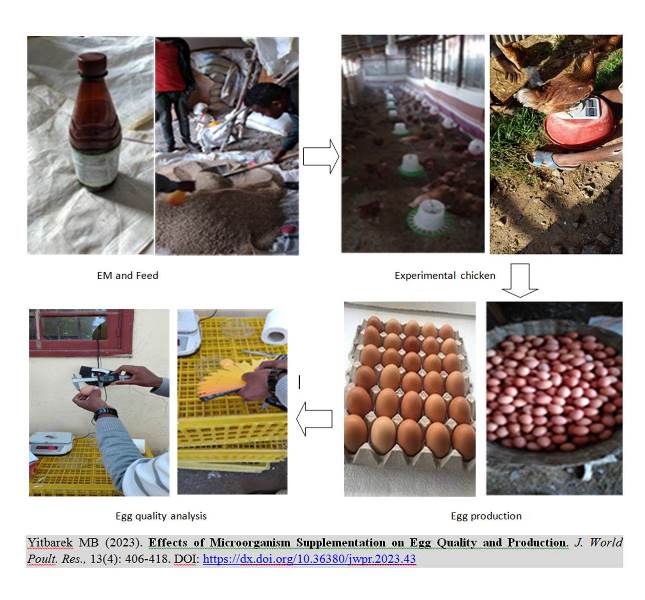Previous issue | Next issue | Archive
Volume 13 (4); December 25, 2023 [Booklet]
|
|
Review
The Importance and Challenges of Primary Chicken Embryo Liver Cells in Studies of Poultry Viral Diseases: A Review
Sohaimi NM and Clifford UC.
J. World Poult. Res. 13(4): 364-372, 2023; pii: S2322455X2300039-13
DOI: https://dx.doi.org/10.36380/jwpr.2023.39
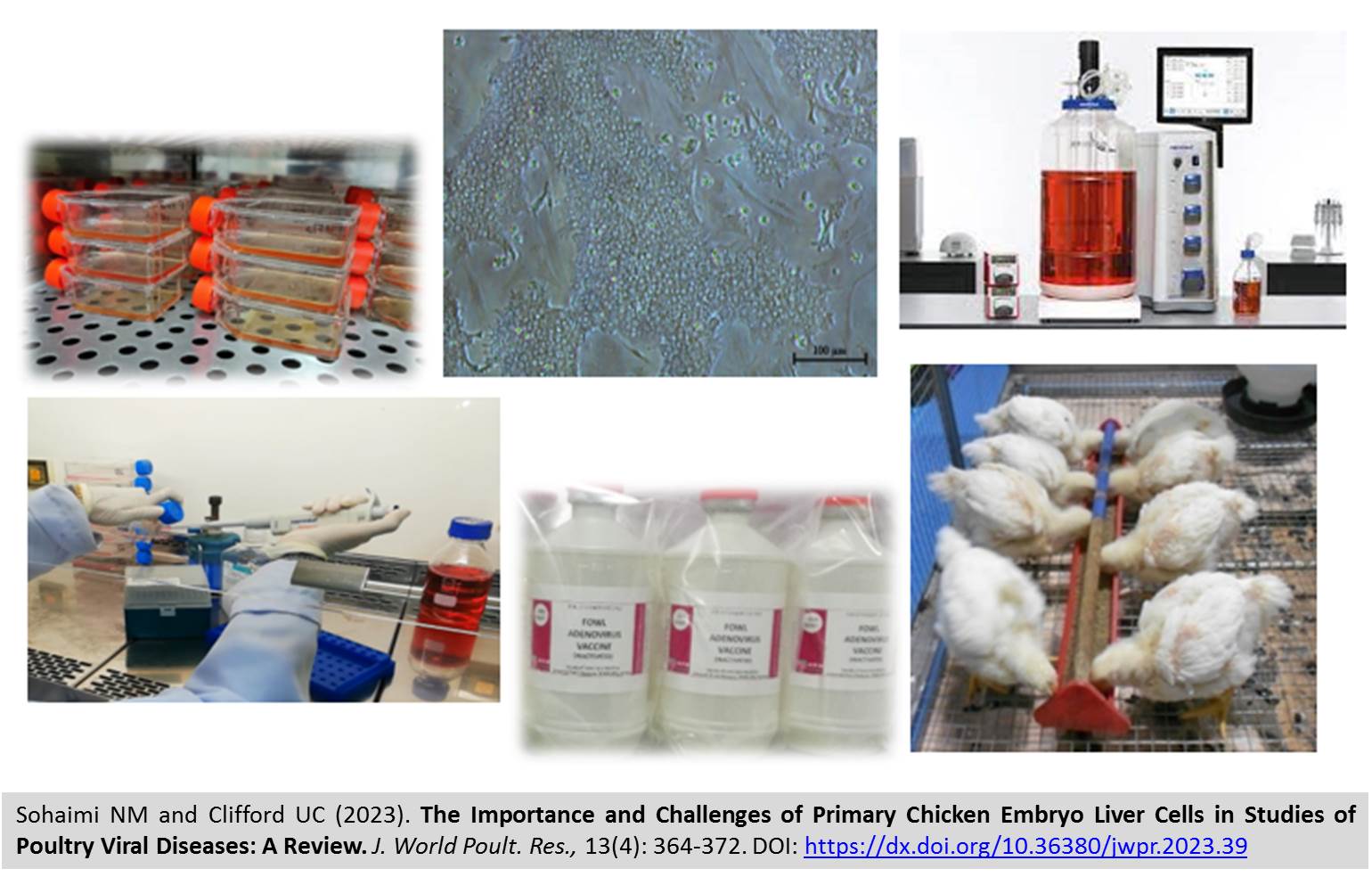 ABSTRACT: Primary chicken embryo liver (CEL) cells are derived from the liver tissue of chicken embryonated eggs (CEE) using an aseptic isolation technique and growth under a controlled atmosphere in an artificial environment for cell attachment and proliferation. Although this primary cultured cell has been established for more than six decades, utilization of primary cells is still the preferable medium nowadays as the “gold standard” due to several advantages over other diagnostic techniques. Cells provide better adaptability of the viruses and easily mimic the natural host environment with high virus titration. The volume of virus suspension could be increased by applying an immortal chicken embryo liver-derived cell line. The current review aimed to highlight the importance and challenges of using primary chicken embryo liver cells in poultry virus studies. Primary CEL cells are widely used as an alternative host for diagnosis of infectious poultry viruses, cultivation and passaging of virus isolates, and vaccine production. Yet, there are some challenges and limitations in handling this primary cell, which requires appropriate facilities and environment to sustain the rapid growth of confluent monolayer cells, as highlighted in this paper. The availability of specific pathogen-free CEE is a major concern due to limited resources globally, thus creating a challenge for vaccine manufacturers to upscale the cultured cells. Future improvement of primary cell culture preparation necessitates new technology by applying cellular microcarrier in the bioreactor machine for efficient cell growth and subsequent routine virus cultivation. This study can help the researchers understand the advantages of primary CEL cells and their applications due to their significant impact on poultry viruses.
ABSTRACT: Primary chicken embryo liver (CEL) cells are derived from the liver tissue of chicken embryonated eggs (CEE) using an aseptic isolation technique and growth under a controlled atmosphere in an artificial environment for cell attachment and proliferation. Although this primary cultured cell has been established for more than six decades, utilization of primary cells is still the preferable medium nowadays as the “gold standard” due to several advantages over other diagnostic techniques. Cells provide better adaptability of the viruses and easily mimic the natural host environment with high virus titration. The volume of virus suspension could be increased by applying an immortal chicken embryo liver-derived cell line. The current review aimed to highlight the importance and challenges of using primary chicken embryo liver cells in poultry virus studies. Primary CEL cells are widely used as an alternative host for diagnosis of infectious poultry viruses, cultivation and passaging of virus isolates, and vaccine production. Yet, there are some challenges and limitations in handling this primary cell, which requires appropriate facilities and environment to sustain the rapid growth of confluent monolayer cells, as highlighted in this paper. The availability of specific pathogen-free CEE is a major concern due to limited resources globally, thus creating a challenge for vaccine manufacturers to upscale the cultured cells. Future improvement of primary cell culture preparation necessitates new technology by applying cellular microcarrier in the bioreactor machine for efficient cell growth and subsequent routine virus cultivation. This study can help the researchers understand the advantages of primary CEL cells and their applications due to their significant impact on poultry viruses.
Keywords: Chicken embryonated eggs, Embryo liver cells, Poultry, Viruses, Vaccine
[Full text-PDF] [Crossref Metadata] [Scopus] [Export from ePrints]
|
|
The Role of Newcastle Disease Virus in Cancer Therapy: A Systematic Review |
Review
The Role of Newcastle Disease Virus in Cancer Therapy: A Systematic Review
Rajaei N, Faraji N, Khabaz PB, Yousefi M, Khavidaki NL, and Omranzadeh A.
J. World Poult. Res. 13(4): 373-385, 2023; pii: S2322455X2300040-13
DOI: https://dx.doi.org/10.36380/jwpr.2023.40
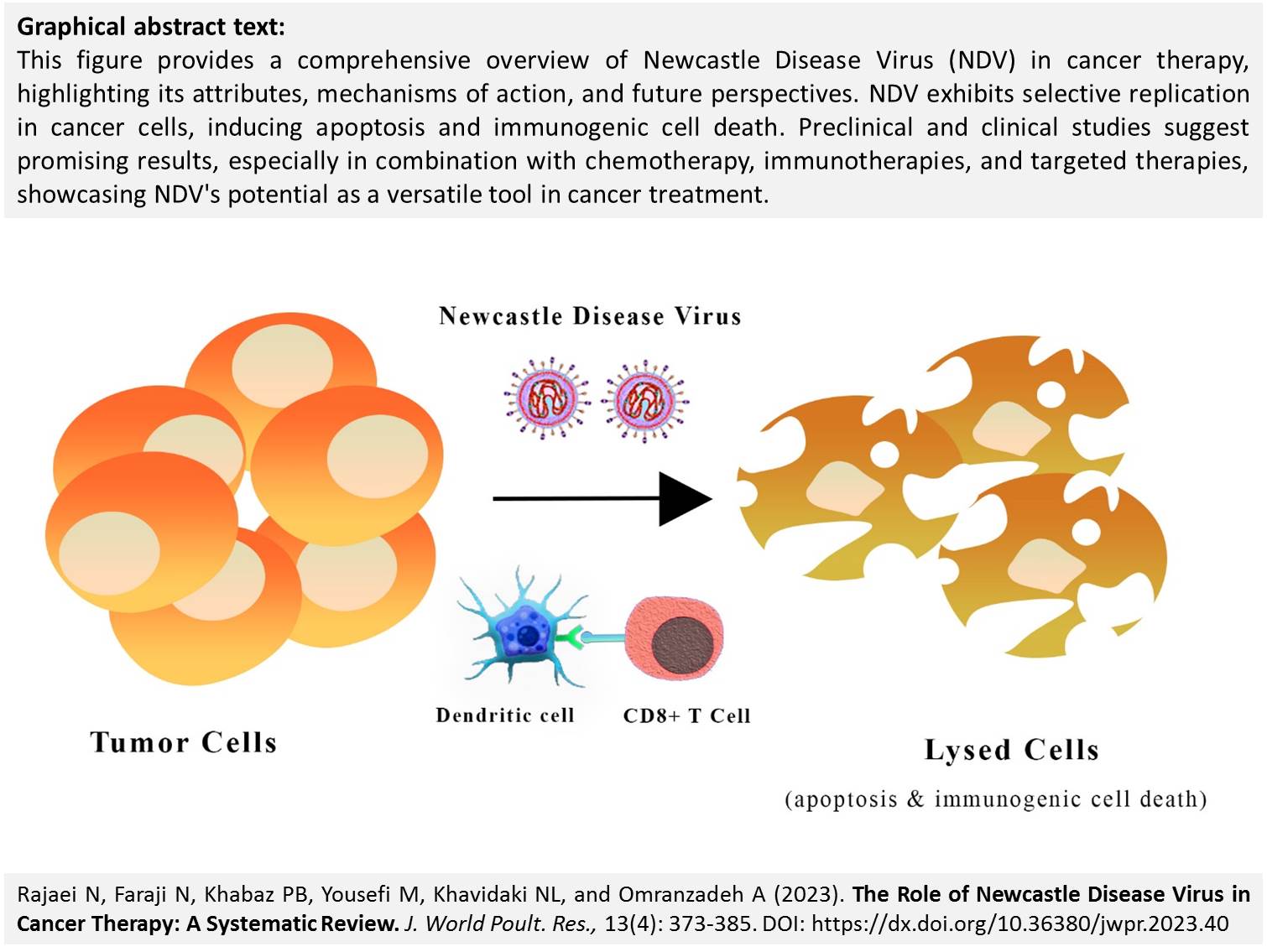 ABSTRACT: Recently, immunotherapy has become a hopeful option for cancer therapy. Taking advantage of pathogens is a well-established method of cancer immunotherapy. It has been shown that the Newcastle disease virus (NDV), an avian virus with oncolytic properties, can be used to treat cancer. This study was designed to offer a comprehensive overview of the role of NDV in cancer treatment, focusing on its attributes, mechanisms of action, preclinical and clinical trials, and future perspectives. A systematic literature review was performed to gather relevant information about NDV in cancer therapy. The inclusion criteria of this study included studies conducted in vitro and in vivo as well as clinical trials to investigate the anti-cancer effects and mechanisms behind the action of NDV. A total of 34 out of 176 academic articles, preclinical studies, clinical trials, and review articles were analyzed to collect key findings. In addition to replicating selectively through invading cancerous cells, NDV has been shown to induce apoptosis in in vivo studies. There is evidence that it can induce apoptosis, induce oncolysis, and modulate immune function in preclinical research. Studies have demonstrated that combining this therapy with chemotherapy, immunotherapies, and targeted therapies provides encouraging results regarding effectiveness and safety in animal models. As a result of NDV’s ability to induce immunogenic cell death, the immune system is activated when it reacts to cancer cells. In addition, NDV infection promotes the recruitment and activation of immune cells, especially cytotoxic T cells, by releasing cytokines and chemokines. This dual mechanism triggers anti-cancer immune responses. An interesting new approach to cancer treatment is based on the selective replication of NDV, which can induce immunogenic cell death in tumor tissues and interfere with oncogenic signaling pathways. Research in preclinical models has yielded valuable information, as well as evidence of the effectiveness and safety of clinical trials. A synergistic effect has been demonstrated when chemotherapy, immunotherapies, and targeted therapies are used in conjunction.
ABSTRACT: Recently, immunotherapy has become a hopeful option for cancer therapy. Taking advantage of pathogens is a well-established method of cancer immunotherapy. It has been shown that the Newcastle disease virus (NDV), an avian virus with oncolytic properties, can be used to treat cancer. This study was designed to offer a comprehensive overview of the role of NDV in cancer treatment, focusing on its attributes, mechanisms of action, preclinical and clinical trials, and future perspectives. A systematic literature review was performed to gather relevant information about NDV in cancer therapy. The inclusion criteria of this study included studies conducted in vitro and in vivo as well as clinical trials to investigate the anti-cancer effects and mechanisms behind the action of NDV. A total of 34 out of 176 academic articles, preclinical studies, clinical trials, and review articles were analyzed to collect key findings. In addition to replicating selectively through invading cancerous cells, NDV has been shown to induce apoptosis in in vivo studies. There is evidence that it can induce apoptosis, induce oncolysis, and modulate immune function in preclinical research. Studies have demonstrated that combining this therapy with chemotherapy, immunotherapies, and targeted therapies provides encouraging results regarding effectiveness and safety in animal models. As a result of NDV’s ability to induce immunogenic cell death, the immune system is activated when it reacts to cancer cells. In addition, NDV infection promotes the recruitment and activation of immune cells, especially cytotoxic T cells, by releasing cytokines and chemokines. This dual mechanism triggers anti-cancer immune responses. An interesting new approach to cancer treatment is based on the selective replication of NDV, which can induce immunogenic cell death in tumor tissues and interfere with oncogenic signaling pathways. Research in preclinical models has yielded valuable information, as well as evidence of the effectiveness and safety of clinical trials. A synergistic effect has been demonstrated when chemotherapy, immunotherapies, and targeted therapies are used in conjunction.
Keywords: Cancer, Immune responses, Newcastle disease, Targeted therapy
[Full text-PDF] [Crossref Metadata] [Scopus] [Export from ePrints]
|
|
Cytology of Turkey Blood-Reactive Hemograms and Measures of Stress |
Research Paper
Cytology of Turkey Blood-Reactive Hemograms and Measures of Stress
Cotter PF.
J. World Poult. Res. 13(4): 386-393, 2023; pii: S2322455X2300041-13
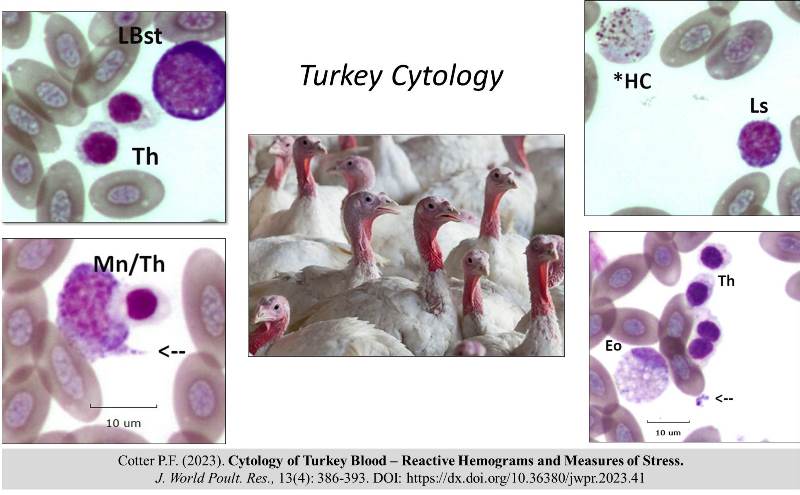 DOI: https://dx.doi.org/10.36380/jwpr.2023.41
DOI: https://dx.doi.org/10.36380/jwpr.2023.41
ABSTRACT: The current study was intended to offer a cytological counterbalance to published descriptions of how processing or other procedures affect turkey welfare. Cytology represents a detailed description of morphological atypia or unusual intracellular or intercellular behavior. The study aimed to describe the variation of blood cells of commercial turkeys. Blood films were collected from 4 turkeys at four different ages of 6, 12, 17, and 19 weeks at commercial farms by a qualified veterinarian. The slides, stained by Wright-Giemsa, were photographed and interpreted off-site. Normal cells of the lymphocyte (L) and heterophil (H) series were described first, followed by examples of atypical cells of other series. These were shown with descriptions of cellularity defined as the proportion of leukocytes in each microscopic field. The results indicated examples of cells whose presence in a standard differential count (SDC) was important enough to disqualify the simple H/L ratio as a stress measure. These cells were atypical members of the lymphoid series, plasmacytes, and other cell types. Atypical granulocytes were heterophils with irregular shapes and faint nuclear staining (hypochromia). An example of a representative total white count revealed how the H/L value could depend on where the cells were counted on the slide. In conclusion, the cytology clearly shows that the presence of atypical cells in a hemogram highlights the inadequacy of relying solely on the simple H/L ratio to estimate stress status.
Keywords: Atypical cytology, Heterophil/Lymphocyte ratio, Stress, Turkey
[Full text-PDF] [Crossref Metadata] [Scopus] [Export from ePrints]
|
|
Research Paper
Eucalyptus globulus as an Alternative to Antibiotics for Isa brown Laying Hens during the Starter Phase
Akue A, Lare L, and Talaki E.
J. World Poult. Res. 13(4): 394-405, 2023; pii: S2322455X2300042-13
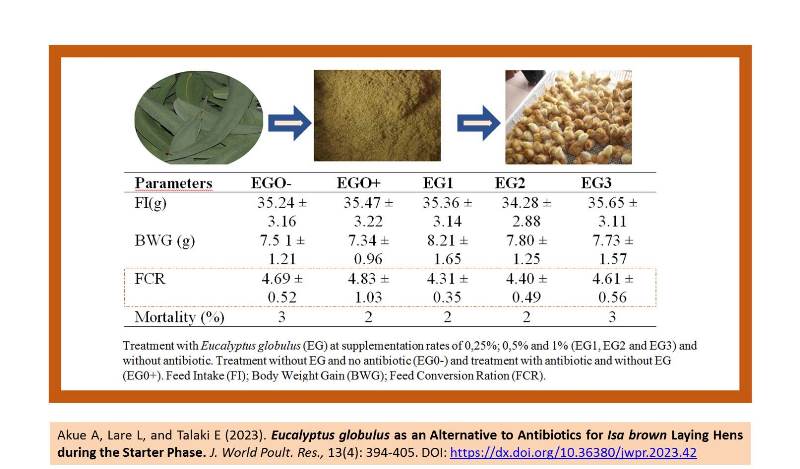 DOI: https://dx.doi.org/10.36380/jwpr.2023.42
DOI: https://dx.doi.org/10.36380/jwpr.2023.42
ABSTRACT: Identification of antibiotic residues in meat and eggs of laying hens in Togo and the ban in 2006 on using antibiotics growth promoter (AGP) in animal production by the World Health Organization induce the use of medicinal plants with antimicrobial effects, such as AGP alternatives in poultry production. For the same purpose, this study was conducted to contribute to studies using phytobiotics as alternatives to AGP in poultry production. Indeed, antibiotics have been substituted by Eucalyptus globulus leaf powder (ELP) during the starter phase. Polyphenolic compounds from ELP were determined, and the effects of different rates of ELP supplementation on growth performance, mortality, and hematological and biochemical parameters were evaluated. A total of 460 one-day-old laying chicks (Isa brown) were randomly allocated to 5 groups, each consisting of 4 replications, with 23 chicks in each replication. Treatments consisted of the basal diet (BD) without ELP and antibiotics, a negative control (group EGO-), BD with antibiotics and no ELP, a positive control (group EGO+), BD + 0.25% of ELP without antibiotic (group EG1), BD with 0.50% of ELP without antibiotic (group EG2), and BD with 1% ELP without antibiotic (group EG3). The rates of 0.25%, 0.5%, and 1% mean 0.25 kg, 0.5 kg, and 1 kg of ELP for 100 kg of BD, respectively. The study revealed that ELP contains flavonoids (4.85 μg QE/mg), tannins (30.34 μg CE/mg), and total phenols (165.2 μg AGE/mg). Supplementation did not affect feed intake (FI), body weight gain (BWG), feed conversion ratio, and mortality of Isa brown laying hens during the starter phase (8 weeks) in all treatment groups. However, the chicks that received ELP had the best FI and BWG, which was not significantly different from the control groups. The biochemical parameters such as total proteins, albumin, triglyceride, total cholesterol, and glycemia were not affected by ELP supplementation. Among the hematology parameters, the leukocyte decreased in the groups fed with ELP, while mortality was unaffected. The results of the present study indicated that ELP inclusion rate of 0.25% could serve as the best antibiotic replacement for Isa brown laying hens during the starter phase.
Keywords: Eucalyptus globulus, Growth parameters, Isa brown, Starter
[Full text-PDF] [Crossref Metadata] [Scopus] [Export from ePrints]
|
|
Effects of Microorganism Supplementation on Egg Quality and Production |
Research Paper
Effects of Microorganism Supplementation on Egg Quality and Production
Yitbarek MB.
J. World Poult. Res. 13(4): 406-418, 2023; pii: S2322455X2300043-13
DOI: https://dx.doi.org/10.36380/jwpr.2023.43
ABSTRACT: Effective microorganism (EM) is a combination of more than 80 different types of beneficial microorganisms contributing to a wide range of applications in medicine, environment, and agriculture (livestock sector, crop sector, and forestry). This experiment was conducted to evaluate the effects of EM supplementation on hen day egg production and egg quality traits of Bovans Brown laying hens. At the age of 16 weeks, 144 pullets were purchased from small-scale poultry farms in Debre Markos. The chickens were divided into four treatments, each of which was replicated three times and contained 12 chickens. The treatment groups were T1 (control, commercial ration only), T2 (supplemented 16 ml EM per liter of drinking water), T3 (supplemented 5% Bokashi in feed), and T4 (supplemented 16 ml EM per liter of drinking water and 5% Bokashi in feed). Prior to collecting the actual data, the layer chickens had 2 weeks of adaptation. The hen day egg production was evaluated, and laboratory analysis was conducted to detect the external and internal egg quality. The results showed no significant difference among treatments on hen day egg productions, which ranged from 74 to 80 percent. Among the external egg quality traits, T4 had the highest egg weight, compared to other treatment groups. The T3 and T4 treatments had the highest shell weight. The shell thickness ranged from 0.37 to 0.39 mm. The shape index ranged from 76.81 to 79.11%, with no difference among the groups. Moreover, T4 had a significantly higher egg mass than T1 and T2. The specific gravity of an egg ranged from 1.06 to 1.08 g/cm3. Among the internal egg quality traits, the albumin weights of T3 and T4 were significantly higher than those of T1. The highest and the lowest Hough units were observed in T4 and T1, respectively. The highest yolk weight was observed in T4 among the groups. The yolk index ranged from 0.45 to 0.49. The yolk color ranged from 5.27 to 7.33. Finally, overall egg quality parameters in T4 were better than in non-supplemented groups.
Keywords: Bovans Brown laying hen, Effective microorganism, Egg quality traits, Hen day egg production
[Full text-PDF] [Crossref Metadata] [Scopus] [Export from ePrints]
|
|
Research Paper
The Impacts of Body Condition, Microclimate, Wind Speed, and Air Pollutant on Physiological Response of Laying Hen Reared under Tropical Climate
Prayogi HS, Suyadi, Nurgiartiningsih VMA, and Sofjan O.
J. World Poult. Res. 13(4): 419-425, 2023; pii: S2322455X2300044-13
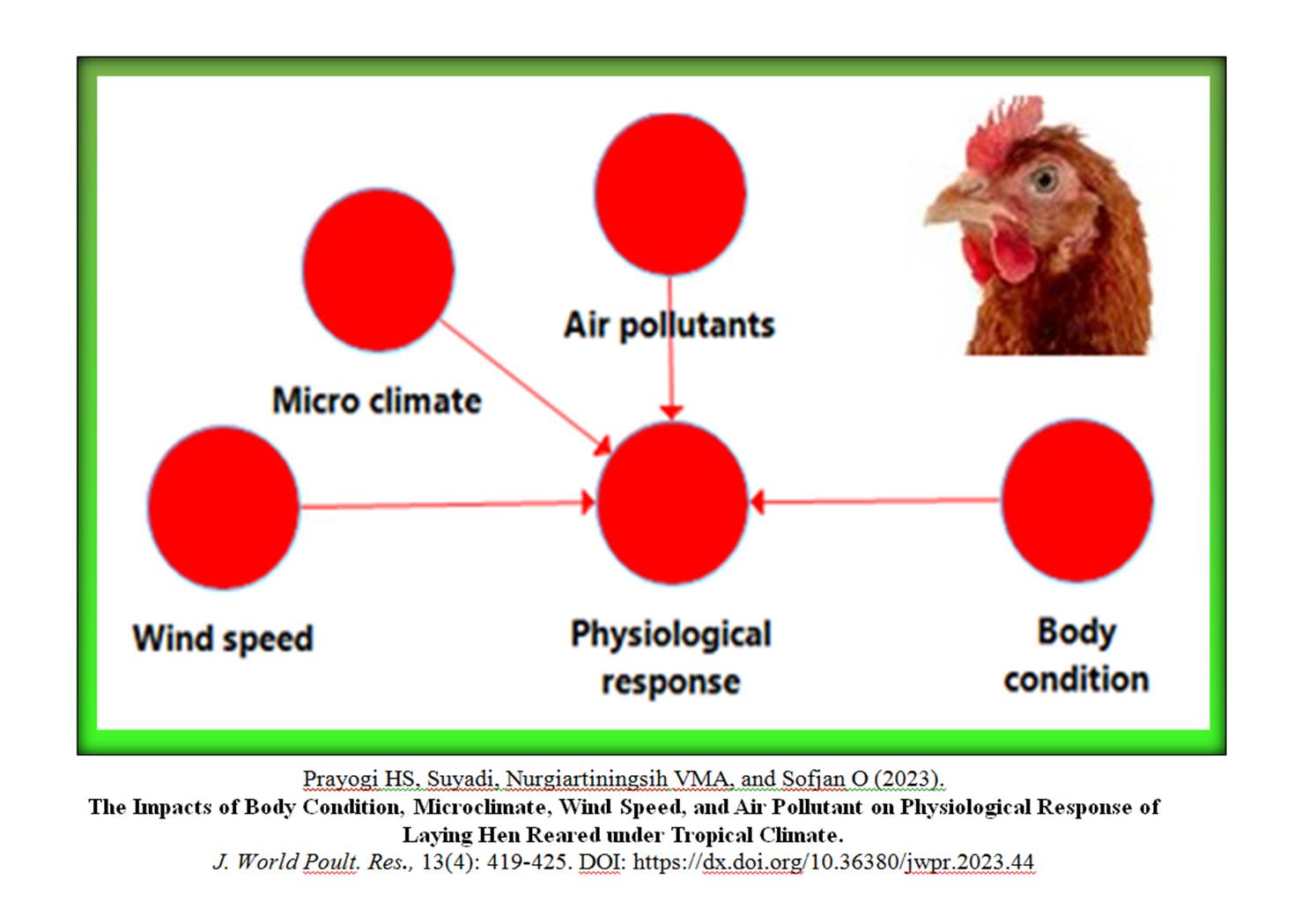 DOI: https://dx.doi.org/10.36380/jwpr.2023.44
DOI: https://dx.doi.org/10.36380/jwpr.2023.44
ABSTRACT: The environmental changes in the animal’s body status could manifest as a physiological response. The present study investigated the impact of body condition, microclimate, wind speed, and air pollutants on the physiological response of laying hens. Therefore, a total of 172 laying hens at 16 weeks of age from Isa Brown were investigated for 5 days. Data on body condition, microclimate, wind speed, and physiological response were recorded and then analyzed using the SEM model by Partial Least Square- Structural Equation Modeling using smartPLS. The obtained result revealed that 59.71% of the physiological response of the chickens (respiratory rate and rectal temperature) reared at the open house system could be predicted by the independent. The microclimate (y = 0.465) was found to be more effective than body condition (y = 0.237), wind speed (y = -0.364), and air pollutant (y = 0.08). Moreover, it was found that as much as 83.1% of the air pollutants in the open house system could be predicted by the independent variables, and wind speed (y = -0.890) was more effective than microclimate (y = 0.074) variables.
Keywords:Laying hen, Microclimate, Physiological response, Tropical climate
[Full text-PDF] [Crossref Metadata] [Scopus] [Export from ePrints]
|
|
Quail Farming in Villages of Mogoditshane-Thamaga and Tlokweng Districts, Botswana |
Research Paper
Quail Farming in Villages of Mogoditshane-Thamaga and Tlokweng Districts, Botswana
Bhawa S, Moreki JC, and Manyeula F.
J. World Poult. Res. 13(4): 426-439, 2023; pii: S2322455X2300045-13
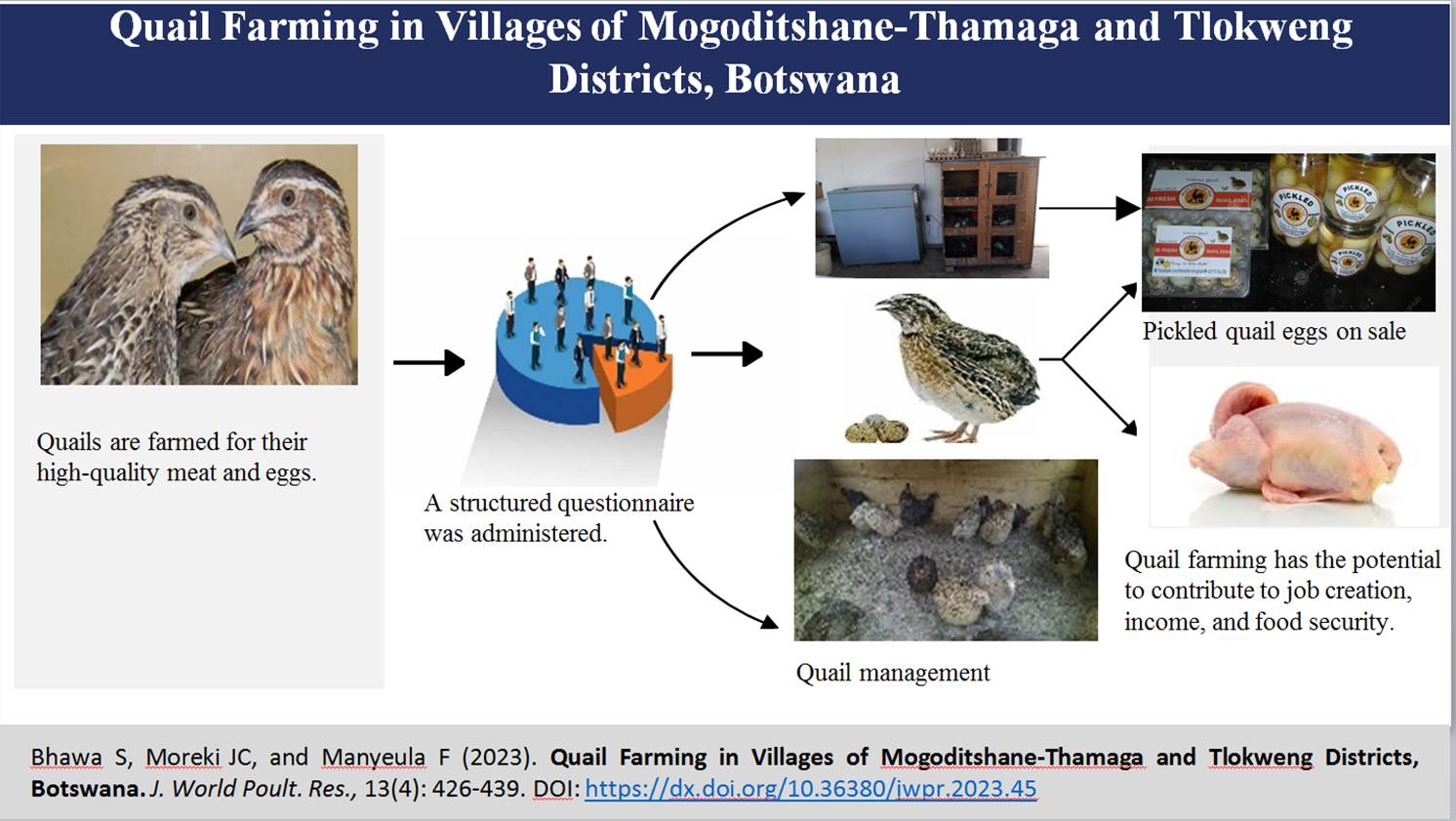 DOI: https://dx.doi.org/10.36380/jwpr.2023.45
DOI: https://dx.doi.org/10.36380/jwpr.2023.45
ABSTRACT: A The interest in quail farming has been increasing over the years due to the quail’s many productive and financial benefits over other poultry species. Quail farming is still in its infancy in Botswana. This study investigated the current status, challenges, and prospects of Japanese quail farming in Mogoditshane, Gabane, and Tlokweng districts, Botswana. A total of 64 quail farmers were interviewed using a structured questionnaire from June 2022 to April 2023. Data were collected on the respondents’ demographic characteristics (age, educational status, and sex), quail management aspects (feeding, housing, and health), ownership of quail, challenges in quail farming, and the use of quail products in the study area. Results showed that 67% of male respondents were involved in quail rearing. The youth (≤35 years) dominated the rearing of quails, followed by respondents aged 41-50 years (22%), 36-40 years (16%), and above 50 years (9%). In addition, 48% of the respondents reared ≤100 quails, followed by 39% and 13% who reared 101-500 and 500 quails, respectively. Furthermore, 81% of respondents reared quails in cages, 17% in conventional structures, and 2% in residential houses. Bobwhite, Jumbo, and Japanese quail were the three quail varieties reared in the study area. It was found that 55% of the respondents had less than one year of experience in quail farming. Moreover, 86% of the respondents used crushed maize or sorghum to feed quails, while 14% used commercial chicken diets. Finally, 92% of the respondents mentioned that quail eggs were used to treat various human diseases. Effective challenges in quail farming included external parasites (36%), diseases (30%), predation (13%), lack of commercial quail diets (12%), escaping (6%), and theft (3%). Quail farming should be considered for inclusion in government support programs as it has the potential to contribute to income generation and food and nutrition security.
Keywords: Food security, Job creation, Nutrition, Quail farming, Therapeutic properties
[Full text-PDF] [Crossref Metadata] [Scopus] [Export from ePrints]
|
|
Research Paper
Genetic diversity, Population Structure and their Association with Body Weight in Egyptian Chicken Strains
El-Komy EM, Darwish HR, Ali NI, Ramadan GS, Salem LM, and Mahrous KF.
J. World Poult. Res. 13(4): 440-449, 2023; pii: S2322455X2300046-13
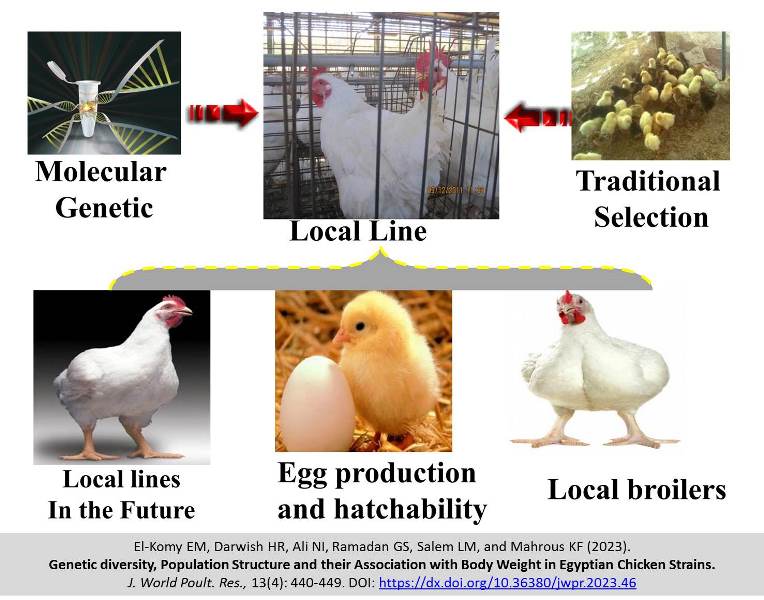 DOI: https://dx.doi.org/10.36380/jwpr.2023.46
DOI: https://dx.doi.org/10.36380/jwpr.2023.46
ABSTRACT: A Genetic characteristics and population structure within and among Egyptian indigenous chicken strains are important for identifying some genetic resources. The present study aimed to use microsatellite markers to determine similarity and genetic distance among different genotypes and their association with growth and production traits in Egyptian indigenous chicken strains. The current study included 800 chickens and 100 genomic DNA samples obtained from four Egyptian local chicken strains of four different areas (Dokki-4, Mandarah, Anshas, and Al-Salam) in Egypt. Their genetic characteristics, population structure, phylogenetic relationships, and their association with body weight were analyzed using seven microsatellite markers. The performance of 200 chicks from each strain was assessed in terms of individual body weight and growth rate. Al-Salam strain had a significantly higher body weight than the other strains up to 12 weeks of age among the four lines of Egyptian local chickens. Additionally, male chickens across all strains indicated significantly higher body weight than females from 2 weeks of age until the end of the experiment. The study revealed a total of 68 alleles from the 7 loci across 4 chicken strains, with an average of 9.71. The average of observed heterozygosity, expected heterozygosity, and polymorphism information content were 0.799, 0.358, and 0.707, respectively. The Mandarah strain had the highest observed allele number of 5.37; however, the lowest observed allele number was 3.12 for the Dokki strain. Analysis of population structure revealed that the four chicken strains should be divided into three clusters based on the highest log-likelihood values (ΔK value, 56.3). The results showed a degree of heterozygosity in the Mandara strain with 66.7% individual memberships, indicating a level of admixture. On the other hand, the Al-Salam strain indicated a high genetic diversity with 99% individual membership. The current study provides valuable insights for future genetic polymorphism studies, the advancement of breeding programs, and strategies for the conservation of the Egyptian local chicken strains.
Keywords: Body weight, Chicken, Genetic diversity, Microsatellite
[Full text-PDF] [Crossref Metadata] [Scopus] [Export from ePrints]
Previous issue | Next issue | Archive
This work is licensed under a Creative Commons Attribution 4.0 International License (CC BY 4.0).![]()

